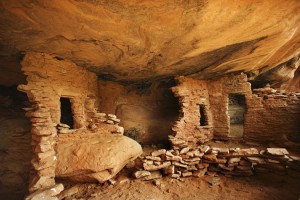 Archaeologists excavating the Anasazi Pueblo site at Sacred Ridge, Colorado, have found an enormous deposit of mutilated human remains. Mass graves have been found before at Ancestral Pueblo sites, some of them showing evidence of horrific violence, cannibalism, deliberate desecration of the dead, probably inflicted to terrify enemies.
Archaeologists excavating the Anasazi Pueblo site at Sacred Ridge, Colorado, have found an enormous deposit of mutilated human remains. Mass graves have been found before at Ancestral Pueblo sites, some of them showing evidence of horrific violence, cannibalism, deliberate desecration of the dead, probably inflicted to terrify enemies.
The Sacred Ridge charnel pit, however, is the earliest and definitely the largest ever found. It dates to around 800 A.D., a period when the first Ancestral Pueblo villages were forming.
The entire assemblage comprises 14,882 human skeletal fragments, as well as the mutilated remains of dogs and other animals killed at the massacre site — Sacred Ridge, southwest of Durango, Colo.
Based on the archaeological findings, which include two-headed axes that tested positive for human blood, co-authors Jason Chuipka and James Potter believe the genocide occurred as a result of conflict between different Anasazi Ancestral Puebloan ethnic groups.
“It was entirely an inside job,” Chuipka, an archaeologist with Woods Canyon Archaeological Consultants, told Discovery News.
“The type of event at Sacred Ridge is on the far end of the conflict spectrum where social relations completely melt down,” he added, mentioning that the Sacred Ridge “occupants were targeted to take the blame.” […]
The unearthed bones and artifacts indicate that when the violence took place, men, women and children were tortured, disemboweled, killed and often hacked to bits. In some cases, heads, hands and feet appear to have been removed as trophies for the killers. The attackers then removed belongings out of the structures and set the roofs on fire.
Chuipka and Potter think the slaughter was the result of massive social stress possibly coupled with severe environmental hardship like a drought, and that the deceased were targeted as group scapegoats. Biodistance analysis done on the teeth of Sacred Ridge human remains indicate that the dead were genetically connected to each other and distinct from neighboring populations. The extent of the mutilations and their systematic disposal suggest the mass killings were planned as such, not spur of the moment responses to circumstances like the other Ancestral Pueblo mass graves which show evidence of starvation cannibalism, war and witch hunts.
These unique characteristics of the Sacred Ridge mass grave suggest to the authors of the study intentional ethnic cleansing. Click here to read an abstract of the study or the study itself if you have a subscription.